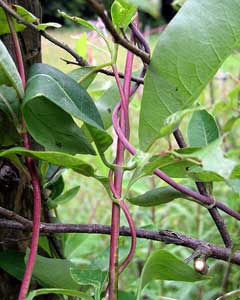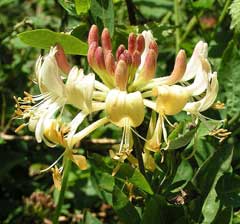 |
|
http://commons.wikimedia.org/wiki/User:Asio_otus |
 |
| http://en.wikipedia.org/wiki/User:Sannse |
Translate this page:
Summary
Physical Characteristics

 Lonicera periclymenum is a deciduous Climber growing to 4.5 m (14ft 9in) at a medium rate.
Lonicera periclymenum is a deciduous Climber growing to 4.5 m (14ft 9in) at a medium rate.
See above for USDA hardiness. It is hardy to UK zone 4 and is not frost tender. It is in flower from June to August, and the seeds ripen from July to October. The species is hermaphrodite (has both male and female organs) and is pollinated by Bees, Lepidoptera (Moths & Butterflies). The plant is self-fertile.
It is noted for attracting wildlife.
Suitable for: light (sandy), medium (loamy) and heavy (clay) soils. Suitable pH: mildly acid, neutral and basic (mildly alkaline) soils and can grow in very acid and very alkaline soils.
It can grow in full shade (deep woodland) semi-shade (light woodland) or no shade. It prefers moist soil and can tolerate drought.
UK Hardiness Map
US Hardiness Map
Synonyms
Plant Habitats
Woodland Garden Sunny Edge; Dappled Shade; Shady Edge; not Deep Shade; Ground Cover; Hedgerow;
Edible Uses
Edible Parts: Flowers Nectar
Edible Uses:
Children (of all ages) suck the base of the flowers to extract the nectar[66].
References More on Edible Uses
Medicinal Uses
Plants For A Future can not take any responsibility for any adverse effects from the use of plants. Always seek advice from a professional before using a plant medicinally.
Antispasmodic Astringent Cathartic Depurative Diaphoretic Diuretic Emetic Expectorant
Febrifuge Laxative Mouthwash Skin Vulnerary
The plant has expectorant and laxative properties[4]. A syrup made from the flowers has been used in the treatment of respiratory diseases whilst a decoction of the leaves is considered beneficial in treating diseases of the liver and spleen[4]. It is used as a mouthwash for ulcers[66] and is considered to be a good ingredient in gargles[4]. The flowers are antispasmodic, astringent, diuretic, expectorant, febrifuge and sudorific[240]. The fruit is emetic and cathartic[4]. The herbage is used as a cutaneous and mucous tonic and as a vulnerary[4]. It is also diaphoretic[4]. The leaves are laxative and slightly astringent[240]. The seed is diuretic[4]. The bark is anticatarrhal, depurative, diuretic and sudorific[240].
References More on Medicinal Uses
The Bookshop: Edible Plant Books
Our Latest books on Perennial Plants For Food Forests and Permaculture Gardens in paperback or digital formats.

Edible Tropical Plants
Food Forest Plants for Hotter Conditions: 250+ Plants For Tropical Food Forests & Permaculture Gardens.
More

Edible Temperate Plants
Plants for Your Food Forest: 500 Plants for Temperate Food Forests & Permaculture Gardens.
More

More Books
PFAF have eight books available in paperback and digital formats. Browse the shop for more information.
Shop Now
Other Uses
A climbing plant, it can be allowed to scramble on the ground where it makes a good ground cover[208]. Plants should be spaced about 1.2 metres apart each way[208]. A very good moth and butterfly plant[30], it is also an important food for many caterpillars including the larvae of the rare white admiral butterfly[186]. The dense growth of the plant offers good nesting possibilities for birds[186].
Special Uses
Attracts Wildlife Food Forest Ground cover Scented Plants
References More on Other Uses
Cultivation details
Succeeds in most soils from acid to base-rich[186]. Prefers its roots in the shade with its shoots climbing up into the sun[200]. Plants succeed even in quite deep shade[219]. Established plants are fairly drought tolerant[190]. Plants are hardy to about -20°c[184]. A very ornamental plant[1], there are a number of named varieties[184]. The flowers are very fragrant, especially in the evening when it attracts pollinating moths[186, 245]. New leaves often start to open in January with well-grown leaves in April[186]. The leaves fall in November[186]. Twining plants, they can bind themselves so tightly round young trees that they can prevent the trunk from being able to expand[186]. A very good moth and butterfly plant[30], it is also an important food for many caterpillars including the larvae of the rare white admiral butterfly[186]. The dense growth of the plant offers good nesting possibilities for birds[186]. In garden design, as well as the above-ground architecture of a plant, root structure considerations help in choosing plants that work together for their optimal soil requirements including nutrients and water. The root pattern is branching: a heart root, dividing from the crown into several primary roots going down and out [2-1].
References Carbon Farming Information and Carbon Sequestration Information
Temperature Converter
Type a value in the Celsius field to convert the value to Fahrenheit:
Fahrenheit:
The PFAF Bookshop
Plants For A Future have a number of books available in paperback and digital form. Book titles include Edible Plants, Edible Perennials, Edible Trees,Edible Shrubs, Woodland Gardening, and Temperate Food Forest Plants. Our new book is Food Forest Plants For Hotter Conditions (Tropical and Sub-Tropical).
Shop Now
Plant Propagation
Seed - best sown as soon as it is ripe in a cold frame. Stored seed requires 2 months cold stratification[113] and should be sown as soon as possible in a cold frame. When they are large enough to handle, prick the seedlings out into individual pots and grow them on in the greenhouse for their first winter. Plant them out into their permanent positions in late spring or early summer, after the last expected frosts. Cuttings of half-ripe wood, 7 - 10cm with or without a heel, July/August in a frame. Good percentage[78]. Cuttings of mature wood of the current season's growth, 15 - 20cm with or without a heel, November in a cold frame. Good percentage[78]. Layering in autumn[200].
Other Names
If available other names are mentioned here
Native Range
EUROPE: Denmark, United Kingdom, Ireland, Norway (south), Sweden (south), Austria, Belgium, Switzerland, Germany, Netherlands, Poland, Former Yugoslavia, Albania, Greece, Italy, Spain, France, Portugal AFRICA: Morocco
Weed Potential
Right plant wrong place. We are currently updating this section.
Please note that a plant may be invasive in one area but may not in your area so it's worth checking.
Conservation Status
IUCN Red List of Threatened Plants Status :

Growth: S = slow M = medium F = fast. Soil: L = light (sandy) M = medium H = heavy (clay). pH: A = acid N = neutral B = basic (alkaline). Shade: F = full shade S = semi-shade N = no shade. Moisture: D = dry M = Moist We = wet Wa = water.
Now available:
Food Forest Plants for Mediterranean Conditions
350+ Perennial Plants For Mediterranean and Drier Food Forests and Permaculture Gardens.
[Paperback and eBook]
This is the third in Plants For A Future's series of plant guides for food forests tailored to
specific climate zones. Following volumes on temperate and tropical ecosystems, this book focuses
on species suited to Mediterranean conditions—regions with hot, dry summers and cool, wet winters,
often facing the added challenge of climate change.
Read More
Expert comment
Author
L.
Botanical References
1117200
Links / References
For a list of references used on this page please go here
Readers comment
© 2010, Plants For A Future. Plants For A Future is a charitable company limited by guarantee, registered in England and Wales. Charity No. 1057719, Company No. 3204567.